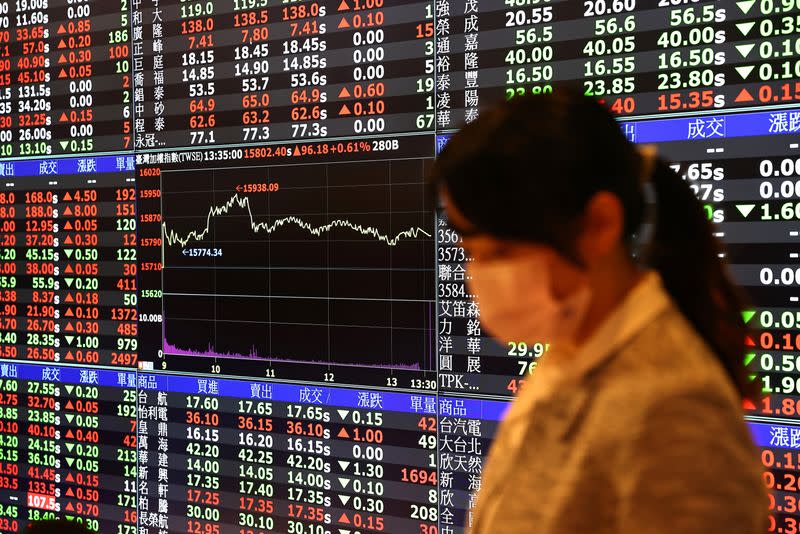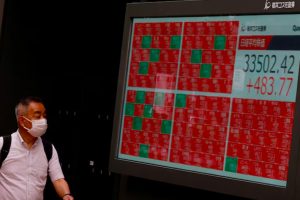Asia’s major stock indexes slipped at the start of the week with investor mood downcast over fading hopes on a US rates turnaround soon and China’s continuing struggles.
Stocks across the region eased and the dollar was firm after a robust US jobs report dashed expectations of a near-term interest rate cut from the Federal Reserve.
But Japan’s Nikkei proved resilient again, edging ahead, buoyed by a weaker yen and gains on Wall Street at the end of last week.
The Nikkei share average was up 0.54%, or 196.14 points, to close at 36,354.16, while the broader Topix was ahead 0.67%, or 17.03 points, to 2,556.71.
Also on AF: Japan Warns Trump: ‘Don’t Do a Deal With China If You Win’
Automakers were among the main beneficiaries of the yen’s slide against the dollar since Friday, when an unexpectedly strong jobs report knocked back expectations for an early Federal Reserve interest rate cut.
Toyota Motor rose 1.37%, Nissan gained 3.31% and Honda advanced 2.97%. Mazda Motor, which is particularly reliant on US sales, jumped 4.13%.
The dollar surged as high as 148.82 yen on Monday for the first time since late November, pulled by a jump in US long-term Treasury yields to the cusp of 4.1% by Monday’s Asian trading.
China stocks slumped for a sixth straight session, with small-cap companies leading the plunge, as investor pessimism worsened on the lack of a clear signal for policy support.
The blue-chip CSI300 Index tumbled as much as 2.1% to refresh a five-year low, before U-turning to close up 0.65%, while the Shanghai Composite Index fell 1.02%, or 27.97 points, to 2,702.18.
The Shenzhen Composite Index on China’s second exchange dived 3.93%, or 58.60 points, to 1,433.10.
Shanghai’s Struggles
Last week, the Shanghai stock benchmark witnessed its worst weekly performance since October 2018, leading many Chinese investors to vent their frustration and anger via social media, including a blog account of the US Embassy in Beijing.
And over the weekend, China’s securities regulator vowed to prevent abnormal market fluctuations, but announced no specific measures.
Adding to investor pessimism, recent economic indicators showed no signs of improving, and the International Monetary Fund on Friday projected that China’s economic growth would slow to 4.6% in 2024 and decline further in the medium-term with growth of about 3.5% projected in 2028.
The Hong Kong market remained relatively stable, with the Hang Seng benchmark edging back 0.15%, or 23.55 points, to 15,510.01.
Elsewhere across the region, in earlier trade, there were also losses in Sydney, Seoul, Mumbai, Singapore, Jakarta and Wellington. Manila and Bangkok edged up.
MSCI’s broadest index of Asia-Pacific shares outside Japan fell 0.21% having dropped more than 1% earlier in the session.
Strong US Payrolls
European bourses looked set for a muted open, with Eurostoxx 50 futures down 0.09%, German DAX futures down 0.19% and FTSE futures up 0.07%.
Global markets have been focused on the timing of when the Fed would start cutting rates since the central bank surprised markets with its dovish tilt in December.
Traders initially priced in March as the starting point of the central bank’s easing cycle but a slate of strong economic data along with resistance from central bankers have led to investors scaling back their bets on an early rate cut.
Markets are currently pricing in an 80% chance of the Fed standing pat on rates in March, compared with a 33% chance at the start of the year, the CME FedWatch tool showed. Traders are now pricing in just below 120 basis points of cuts this year.
The strong payrolls report pushed Treasury yields higher, with the yield on 10-year Treasury notes at 4.066%. Other regional bond yields took the cue and were higher on Monday, with yields on Australia’s 10-year bond and South Korea’s 10-year Treasury bond rising 11 basis points.
The dollar index, which measures the US currency against six major rivals, scaled a fresh eight-week peak of 104.18, pinning the Japanese yen near a two-month low.
US crude rose 0.42% to $72.58 per barrel and Brent was at $77.75, up 0.54% on the day as escalating geopolitical tension and its repercussions on oil supply boosted prices.
Key figures
Tokyo – Nikkei 225 > UP 0.54% at 36,354.16 (close)
Hong Kong – Hang Seng Index < DOWN 0.15% at 15,510.01 (close)
Shanghai – Composite < DOWN 1.02% at 2,702.18 (close)
London – FTSE 100 > UP 0.14% at 7,626.29 (0935 GMT)
New York – Dow > UP 0.35% at 38,654.42 (Friday close)
- Reuters with additional editing by Sean O’Meara
Read more:
Critics Say China’s ‘National Team’ Can’t Fix Its Sinking Markets
Foxconn Warns on AI Chip Shortage But Predicts ‘Better’ 2024
French Shipping Giant Joins Red Sea, Suez Route Boycott
China Markets Hit 6-Year Lows, Nikkei Follows Wall St Rally





















